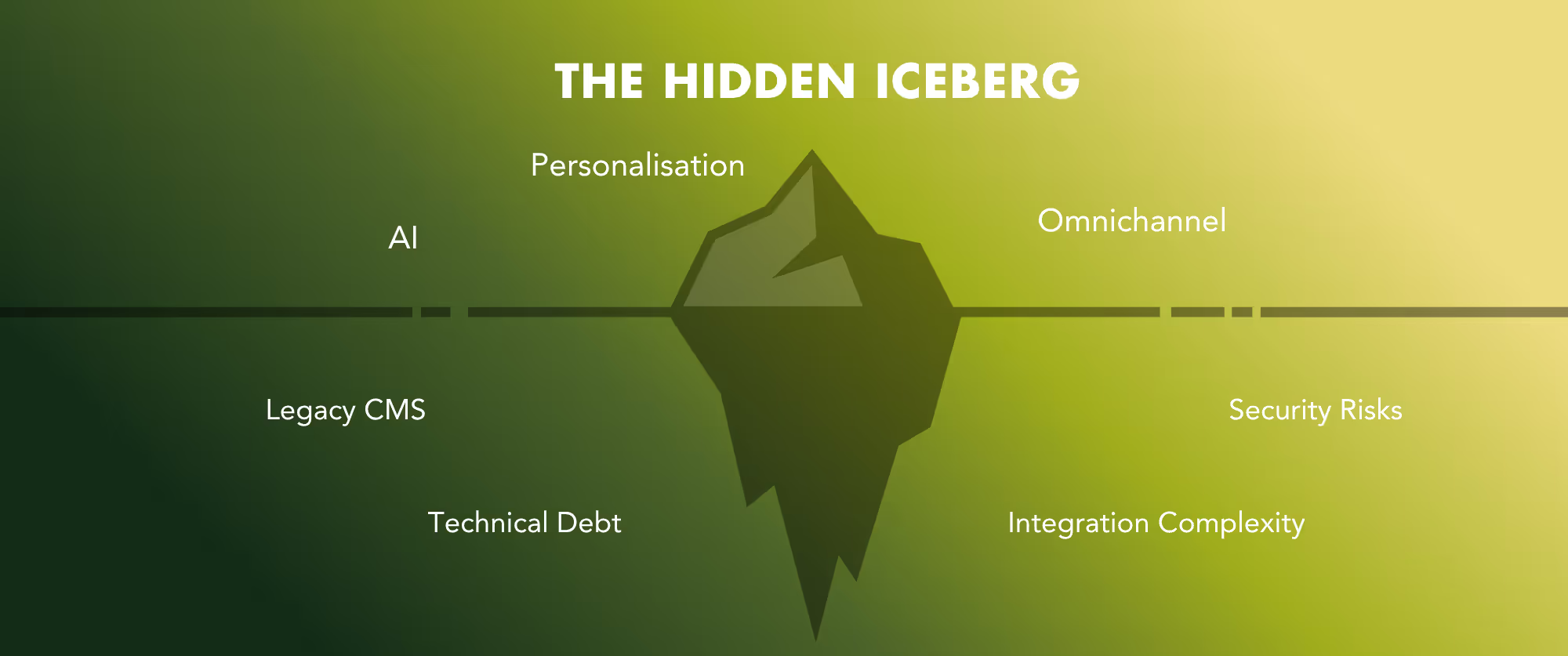

In boardrooms everywhere, digital transformation dominates the conversation. But behind the ambition lies a problem few talk about. The platforms that make these initiatives possible – content management systems (CMS) and digital experience platforms (DXP) – are underfunded, outdated, and often ignored.
This whitepaper reveals the quiet crisis of platform underinvestment that threatens to stall digital progress, weaken competitiveness, and increase exposure to risk. Using current research and real-world examples, it explains why traditional ROI models fail to capture the true value of platform investment and introduces a practical framework for modernising digital foundations.
Key findings:
The cost of inaction rises every day. While boards debate small, incremental changes, competitors with modern platforms move faster, serve customers better, and build stronger market positions. The question is no longer whether to invest in platform modernisation – it’s whether your organisation will lead or be left behind.

Every board understands that strong digital experiences drive business success. What’s often missed is that these experiences rely on increasingly fragile foundations. The platforms that once supported digital growth have now become anchors holding organisations back.
Here’s the reality: while 89% of companies claim to have a digital-first strategy, most are trying to execute it on platforms built for a different time. It’s like running modern software on a decade-old operating system – technically possible, but commercially dangerous.
Modern business relies on connected data. But many organisations still operate a patchwork of systems held together by fragile integrations and manual workarounds. Each connection adds complexity, risk, and cost.
The numbers speak for themselves. Organisations managing disconnected systems report:
In digital markets, speed often determines success. Modern DXPs allow teams to launch campaigns in hours, not weeks. They support real-time personalisation, instant updates, and rapid responses to shifting market conditions.
By contrast, organisations stuck on legacy platforms are left behind. When updating a single landing page needs IT involvement, approval chains, and deployment windows, the opportunity often passes before the change goes live.
Few issues should concern boards more than security. Legacy CMS platforms, especially those dependent on outdated plugins, create what experts call an “expanding attack surface”. Every unpatched component or forgotten integration becomes an open door for attack.
The data is stark:
For boards with fiduciary duties, platform security isn’t a technical problem – it’s a governance responsibility.
The most visible cost of platform neglect is lost revenue. When pages load slowly, personalisation fails, or content doesn’t adapt to mobile, customers leave. Research shows 88% of users don’t return after a poor digital experience.
The impact goes far beyond a few missed sales:
For a B2B service firm with $100 million in annual revenue, platform-related leakage can exceed $5–10 million per year – far more than the cost of replatforming.
Marketing teams hired to drive growth often spend their time battling outdated systems. Simple tasks turn into complex workflows. Creative ideas get watered down to fit platform limits. Innovation stalls as teams work around problems instead of solving them.
The cost in lost time and morale is measurable:
This isn’t just inefficiency – it’s talent drain. Frustrated teams leave for organisations with better tools and fewer barriers.
Every legacy platform eventually becomes a tangled web of plugins, point solutions, and one-off integrations. What starts as a single add-on becomes a costly, unstable ecosystem. Each connection needs constant updates and monitoring, and every API change risks breaking something else.
The hidden costs add up fast:
Organisations report spending 30–40% of digital budgets just keeping these integrations running. That’s money funding stagnation, not innovation.
AI is reshaping how digital experiences are created, delivered, and optimised. But legacy platforms make AI adoption nearly impossible. Without clean data, modern APIs, and flexible architecture, even the best AI strategy stays theoretical.
“While boards discuss AI strategy, legacy platforms ensure those strategies remain theoretical. The platform decision determines whether AI becomes competitive advantage or competitive disadvantage.”
The missed opportunity is immense:
Boards often talk about AI potential. But without modern platforms, those ambitions remain talk. The platform choice determines whether AI becomes a growth engine or a barrier.
The first warning sign appears in the IT budget. When maintenance costs rise 15–30% each year just to preserve existing functionality, the platform has shifted from asset to liability. These costs compound over time, swallowing investment that should fund innovation.
Boards should ask:
Modern websites often rely on 20 or more plugins for basic functions. Each plugin brings:
When essential functionality depends on plugins, the platform has failed. When plugin conflicts cause outages, the business impact is immediate and measurable.
In an age of personalisation, disconnected systems are a major handicap. When customer data sits separately in CRM, analytics, marketing, and content systems, creating consistent experiences becomes impossible.
Warning signs include:
Complexity grows with every new vendor. Organisations managing ten or more providers for core digital operations face:
A neglected platform doesn’t just slow systems – it drives away people. When skilled professionals spend 70% of their time maintaining legacy systems instead of improving them, they leave. The loss isn’t just in headcount, but in expertise and morale.
Modern platforms attract top talent; legacy ones repel it. In a tight labour market, that difference determines long-term capability.
Every integration point, outdated component, or unpatched vulnerability raises cyber risk. For boards, this is not an IT issue – it’s a governance concern.
Red flags include:
Regulations such as GDPR and CCPA demand full visibility and control of data. Legacy platforms make this nearly impossible, exposing organisations to fines of up to 4% of global turnover.
When compliance relies on manual checks across multiple systems, risk becomes unavoidable.
When the main platform can’t meet business needs, departments go elsewhere. Shadow IT appears as teams deploy their own tools to get things done. This creates:
For organisations that value simplicity and control, unified DXP platforms provide a strong, centralised foundation. These enterprise-grade systems bring together content management, personalisation, analytics, and optimisation within a single environment.
Leading unified platforms deliver measurable results:
For organisations that prioritise agility and innovation, headless and composable architectures offer unmatched flexibility. By separating content management from presentation, these platforms make it easy to evolve and adapt as technology changes.
Headless adoption continues to accelerate, with uptake up 25% year on year and market growth projected at 22.6% CAGR through 2035.
Transformation doesn’t have to be all or nothing. Many organisations succeed with a hybrid model that blends unified platform stability with composable flexibility.
This approach offers:
Whether unified or composable, modern DXPs share core capabilities that set high-performing organisations apart.
The financial case for modernising your platform often starts with consolidation. Most organisations find they can dramatically reduce costs while improving visibility, accountability, and speed of decision-making.
For a B2B service firm spending $2 million a year on digital platforms and services, consolidation alone can unlock $600,000–$800,000 annually — funds that can be reinvested in innovation and growth.
Cost reduction is only the beginning. Modern platforms actively drive growth by enabling faster execution, richer customer experiences, and scalable innovation.
For risk-focused boards, modern platforms reduce exposure across security, compliance, and operational continuity.
When boards evaluate investment, they must look at the full three-year impact – not just direct cost but the combined effect on revenue, risk, and operational efficiency.
Total three-year value: $25–30 million
Investment required: $2–3 million
ROI: 800–1000%
The numbers make a simple case: modernising your platform isn’t an expense — it’s one of the highest-yielding investments available to any digital organisation.
The first phase sets the foundation for transformation. It’s about understanding your current landscape, defining the destination, and choosing the right platform to get there.
Before making any decision, gain full visibility into your digital ecosystem.
Clarify what success looks like. This ensures technology choices align with business outcomes.
This is where strategy meets practicality. Evaluate platforms that meet both current and future needs.
Once the platform is chosen, build a strong foundation to ensure long-term success.
This phase focuses on moving and improving the content that fuels your digital experience.
A phased rollout reduces risk, validates value early, and ensures user confidence.
Transformation isn’t complete until the organisation embraces it. Effective change management ensures long-term adoption and return on investment.
Digital platforms sit at the heart of every organisation’s ability to compete, serve customers, and grow.
Yet many board discussions still treat them as background infrastructure rather than strategic assets. The result is years of underinvestment that now expose businesses to mounting risk, higher cost, and slower innovation.
To make informed decisions, boards need clarity on how their digital foundations are performing and what that means for future competitiveness. The following questions help focus that conversation.
The evidence is overwhelming. Underinvesting in platforms creates growing risk – financial, operational, and strategic. While boards debate small improvements, the cost of inaction keeps rising. Every day spent on legacy systems is a day competitors move further ahead.
This isn’t about whether to modernise. It’s about how quickly you start. Market leaders are already acting. Fast followers are moving now. Those who delay will struggle to catch up.
Platform transformation starts with understanding where you are and what’s possible next.
Weak digital foundations put every organisation at risk. But with the right strategy, partner, and commitment, transformation is not only possible – it’s profitable.
Our team will assess your current platform, highlight key risks and opportunities, and outline a clear plan for action. Your executive briefing includes:
Don’t wait for failure to make the decision for you. Take control of your digital foundation now and turn modernisation into an advantage.
.avif)